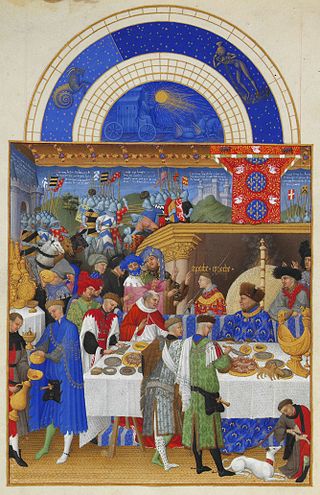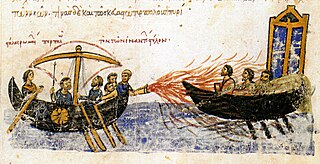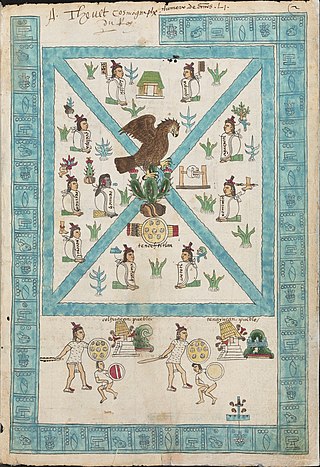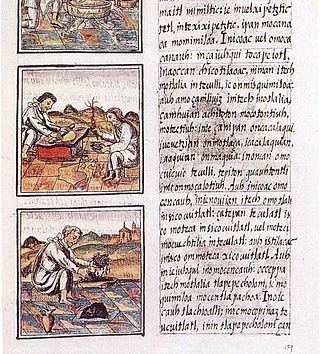The Book of Hours of Leonor de la Vega is a codex of illuminated manuscript on vellum by Willem Vrelant. [1] It is in the National Library of Spain (Vitr.24-2). The pages are 19 x 13 centimeters in size.
The Book of Hours of Leonor de la Vega is a codex of illuminated manuscript on vellum by Willem Vrelant. [1] It is in the National Library of Spain (Vitr.24-2). The pages are 19 x 13 centimeters in size.

The author, Willem Vrelant of Utrecht, was born in 1410 and died in Bruges in 1481. He was a student of Jan van Eyck, and was active in Flanders, where this book of hours was made, between 1465 and 1470. [2]
The manuscript was sent in 1498 as a gift from the ambassador of Spain in Flanders, Diego Ramirez de Villaescusa, to the Spanish ambassador in Rome, Garcilaso de la Vega, the father of the poet Garcilaso de la Vega. The book of hours was named for the poet's sister, Leonor de la Vega, who inherited the codex from her brother. [3]
The manuscript presents a goatskin binding, and is made on parchment folios (202), 19 x 13 cm in size, for a total of 404 pages. A calendar without artwork contrasts with the many illustrations of the different chapters: the Hours of the Virgin, Hours of the Cross, and Hours of the Holy Spirit, with full-page miniatures and borders full of plants, monsters or satirical scenes, with applied gold leaf on many illustrations and much of the lettering. [4] [5]

Pedanius Dioscorides, “the father of pharmacognosy”, was a Greek physician, pharmacologist, botanist, and author of De materia medica —a 5-volume Greek encyclopedia about herbal medicine and related medicinal substances, that was widely read for more than 1,500 years. For almost two millennia Dioscorides was regarded as the most prominent writer on plants and plant drugs.

Garcilaso de la Vega, KOS was a Spanish soldier and poet. Although not the first or the only one to do so, he was the most influential poet to introduce Italian Renaissance verse forms, poetic techniques, and themes to Spain. He was well known in poetic circles during his lifetime, and his poetry has continued to be popular without interruption until the present. His poetry was published posthumously by Juan Boscán in 1543, and it has been the subject of several annotated editions, the first and most famous of which appeared in 1574.

The Très Riches Heures du Duc de Berry or Très Riches Heures, is the most famous and possibly the best surviving example of manuscript illumination in the late phase of the International Gothic style. It is a book of hours: a collection of prayers to be said at the canonical hours. It was created between c. 1412 and 1416 for the extravagant royal bibliophile and patron John, Duke of Berry, by the Limbourg brothers. When the three painters and their sponsor died in 1416, possibly victims of plague, the manuscript was left unfinished. It was further embellished in the 1440s by an anonymous painter, who many art historians believe was Barthélemy d'Eyck. In 1485–1489, it was brought to its present state by the painter Jean Colombe on behalf of the Duke of Savoy. Acquired by the Duc d'Aumale in 1856, the book is now MS 65 in the Musée Condé, Chantilly, France.
Joan Boscà i Almogàver, was a Spanish poet who incorporated hendecasyllable verses into Spanish.
De la Vega is a surname in the Spanish language, most of its bearers belonging to the nobility. It means "of the meadow" and may refer to:
A chansonnier is a manuscript or printed book which contains a collection of chansons, or polyphonic and monophonic settings of songs, hence literally "song-books"; however, some manuscripts are called chansonniers even though they preserve the text but not the music, for example, the Cancioneiro da Vaticana and Cancioneiro da Biblioteca Nacional, which contain the bulk of Galician-Portuguese lyrics.

Simon Bening was a Flemish miniaturist, generally regarded as the last major artist of the Netherlandish tradition.

The Biblioteca Nacional de España is a major public library, the largest in Spain, and one of the largest in the world. It is located in Madrid, on the Paseo de Recoletos.

The Madrid Skylitzes is a richly illustrated illuminated manuscript of the Synopsis of Histories, by John Skylitzes, which covers the reigns of the Byzantine emperors from the death of Nicephorus I in 811 to the deposition of Michael VI in 1057. The manuscript was produced in Sicily in the 12th century, and is now at the Biblioteca Nacional de España in Madrid, with the shelfmark MS Graecus Vitr. 26–2. Other names for it are Codex Græcus Matritensis Ioannis Skyllitzes and Skyllitzes Matritensis.

The Ramírez Codex, not to be confused with the Tovar Codex, is a post-conquest codex from the late 16th century entitled Relación del origen de los indios que hábitan esta Nueva España según sus Historias. The manuscript is named after the Mexican scholar José Fernando Ramírez, who discovered it in 1856 in the convent of San Francisco in Mexico City.

Aztec codices are Mesoamerican manuscripts made by the pre-Columbian Aztec, and their Nahuatl-speaking descendants during the colonial period in Mexico.

The Florentine Codex is a 16th-century ethnographic research study in Mesoamerica by the Spanish Franciscan friar Bernardino de Sahagún. Sahagún originally titled it: La Historia General de las Cosas de Nueva España. After a translation mistake, it was given the name Historia general de las Cosas de Nueva España. The best-preserved manuscript is commonly referred to as the Florentine Codex, as the codex is held in the Laurentian Library of Florence, Italy.

Commentary on the Apocalypse is a book written in the eighth century by the Spanish monk and theologian Beatus of Liébana (730–785) and copied and illustrated in manuscript in works called "Beati" during the 10th and 11th centuries AD. It is a commentary on the New Testament Apocalypse of John or Book of Revelation. It also refers to any manuscript copy of this work, especially any of the 27 illuminated copies that have survived. It is often referred to simply as the Beatus. The historical significance of the Commentary is made even more pronounced since it included a world map, which offers a rare insight into the geographical understanding of the post-Roman world. Well-known copies include the Morgan, the Saint-Sever, the Gerona, the Osma and the Madrid Beatus codices.

The Cancioneiro Musical de Belém or simply Cancioneiro de Belém is a Portuguese Renaissance manuscript from the beginning of the 17th century.

The Hours of James IV of Scotland, Prayer book of James IV and Queen Margaret is an illuminated book of hours, produced in 1503 or later, probably in Ghent. It marks a highpoint of the late 15th century Ghent-Bruges school of illumination and is now in the Austrian National Library in Vienna. It is thought to have been a wedding gift from James IV of Scotland or another Scottish nobleman to James's wife Margaret Tudor on the occasion of their marriage, perhaps finishing a book already started for another purpose. A number of artists worked on the extensive programme of decoration, so that "the manuscript in its entirety presents a rather odd picture of heterogeneity". The best known miniature, a full-page portrait of James at prayer before an altar with an altarpiece of Christ and an altar frontal with James's coat-of-arms, gave his name to the Master of James IV of Scotland, who is now generally identified as Gerard Horenbout, court painter to Margaret of Austria; he did only one other miniature in the book. The equivalent image of Margaret is the only image by another artist, using a rather generic face for the queen's portrait, and in a similar style to that of the Master of the First Prayer Book of Maximilian. Other artists worked on the other miniatures, which include an unusual series of unpopulated landscapes in the calendar – perhaps the Flemish artists were not sure how Scots should be dressed.

The Black Hours, MS M.493 is an illuminated book of hours completed in Bruges between 1460 and 1475. It consists of 121 pages (leaves), with Latin text written in Gothic minuscule script. The words are arranged in rows of fourteen lines and follow the Roman version of the texts. The lettering is inscribed in silver and gold and placed within borders ornamented with flowers, foliage and grotesques, on pages dyed a deep blueish black. It contains fourteen full-page miniatures and opens with the months of the liturgical calendar, followed by the Hours of the Virgin, and ends with the Office of the Dead.

Willem Vrelant was a Dutch book illuminator.

The Hours of Mary of Burgundy is a book of hours, a form of devotional book for lay-people, completed in Flanders around 1477, and now in the National Library of Austria. It was probably commissioned for Mary, the ruler of the Burgundian Netherlands and then the wealthiest woman in Europe. No records survive as to its commission. The book contains 187 folios, each measuring 225 by 150 millimetres. It consists of the Roman Liturgy of the Hours, 24 calendar roundels, 20 full-page miniatures and 16 quarter-page format illustrations. Its production began c. 1470, and includes miniatures by several artists, of which the foremost was the unidentified but influential illuminator known as the Master of Mary of Burgundy, who provides the book with its most meticulously detailed illustrations and borders. Other miniatures, considered of an older tradition, were contributed by Simon Marmion, Willem Vrelant and Lieven van Lathem. The majority of the calligraphy is attributed to Nicolas Spierinc, with whom the Master collaborated on other works and who may also have provided a number of illustrations.

The Madrid Codices I–II, are two manuscripts by Leonardo da Vinci which were discovered in the Biblioteca Nacional de España in Madrid in 1965 by Dr. Jules Piccus, Language Professor at the University of Massachusetts. The Madrid Codices I was finished during 1490 and 1499, and II from 1503 to 1505.